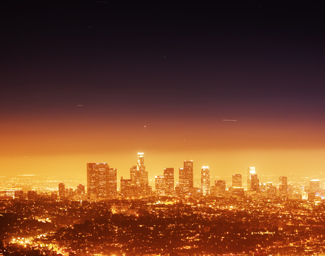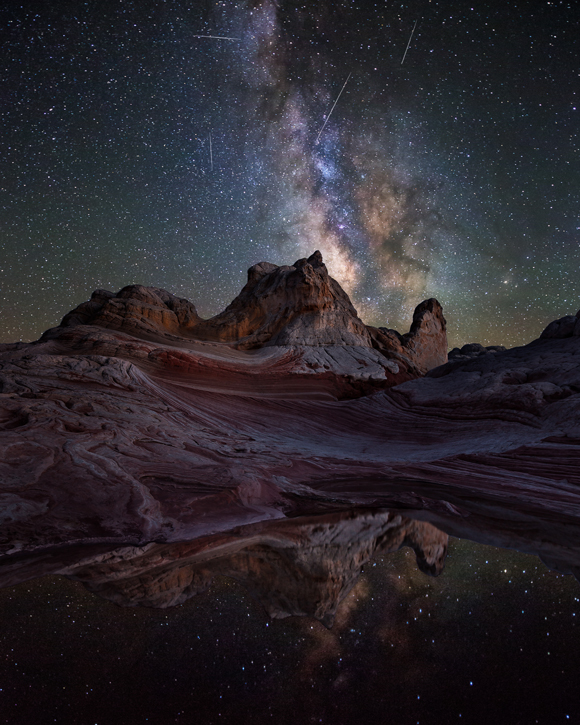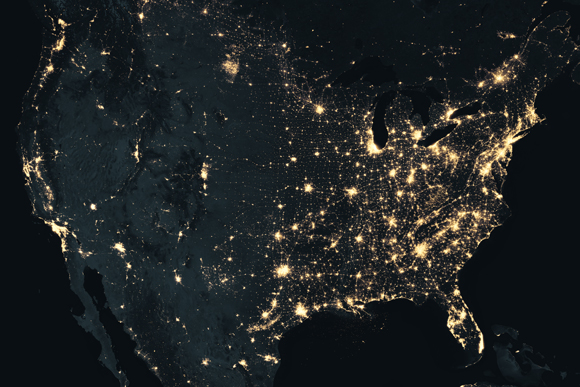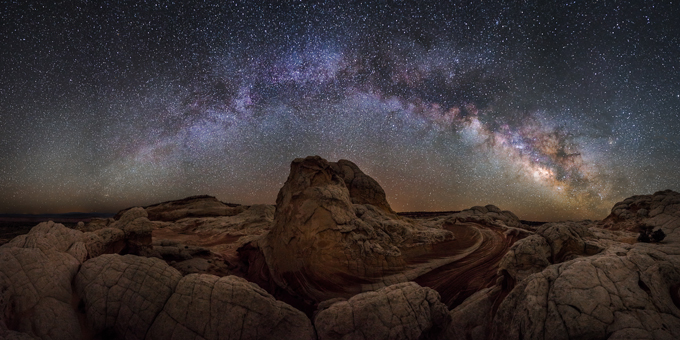After an hour-long drive up Parowan Canyon, Alina Standford (a hiking enthusiast and intrepid camper) turned onto a rickety dirt road just west of Brian Head. The headlights of the car pushed through an ocean of dust with ease, but seemed to lose strength when put up against the looming dark of the night. A graveyard of pine trees stretched endlessly up on either side of the road and obstructed all view of the valley. The road winding up the mountain seemed to never end, but Alina continued with determination. Then, suddenly the tree line broke and gave way to a rocky, cold landscape. Stepping out of the car, Alina went to the edge of the peak—and looked up.
Thousands of stars were splattered across the darkness. The Milky Way cut a hazy purple scar in the sky. There, 11,306 feet above sea level, Alina could see a parade of lights that rivaled those found in even the biggest cities around the world. The stars seemed to ignite against the black background. As Alina stood on the mountain, looking through the vast window to the universe, she couldn’t help but feel there was nothing quite so incredible as the night sky.

The Los Angeles night sky is almost entirely washed away by an ocean of city lights. (Photo by Konstantin Sutyagin. All rights reserved.)
A Yellow Haze
The night sky has been inspiring people to dream and explore for thousands of years. Our sky has guided us through great distances and has taught us infinitely about our universe. But over the years, dark sky is getting harder and harder to find. The night sky is slowly disappearing in the yellowish haze of light pollution. This pollution develops from excessive artificial light found in every city. Street lamps and house lights are often misdirected and compete with the brilliance of the stars. As cities grow, the night sky is shrinking.
By using the Bortle scale, a measurement used to observe the brightness of the night sky, astronomers are able to calculate the looming effects of light pollution. On this scale, if the night sky is rated between a 1 and a 9 (9 being the lightest and 1 being the darkest); most people in the United States live in an area rated between a 5 and an 8 level night sky. Some people cannot imagine what a level 1 or even a level 3 night sky would look like.
The International Dark-sky Association (IDA) works to raise awareness of the problems of light pollution by encouraging more cities to install energy-efficient streetlights. Finding cities and reserves that meet the requirements to be a “dark sky place” is challenging, but the IDA always works towards a world of clear darkness with less yellow fog. Currently, there are fifteen National Parks that meet the requirements the IDA assigned to be a dark sky park. While all are beautiful, nothing beats the dark desert skies of Arizona and southern Utah.

The night sky in Arizona looks to be on fire without any light pollution blocking the stars. (Photo by Jared Warren. All rights reserved.)
Desert Night
Utah and Arizona are famous for infinite red-rock beauty. Many people from around the world have endured the long drive through the desert to appreciate spectacular natural beauties of the earth such as the Grand Canyon or Natural Bridges National Monument. Through many centuries, wind and water have left their mark, carving beautiful canyons and structures into the rock face that stand as monuments in the unique landscape. But these states offer more than just beautiful rocks. A lesser-known beauty of the desert is the night sky.
The dry night provides ideal conditions to see millions of twinkling pinpricks in a sea of black. On clear nights, the Milky Way can be seen ripping across the heavens. In beautiful, isolated places, stargazers can even spot the cloudy splotch of the Andromeda Galaxy: the furthest object from the earth that can be viewed with the naked eye. There is perhaps nothing more beautiful than a starry night.
In Carl Sagan’s book Pale Blue Dot: A Vision of the Human Future in Space, Sagan remarked, “Before we devised artificial lights and atmospheric pollution and modern forms of nocturnal entertainment we watched the stars. There were practical calendar reasons of course but there was more to it than that. Even today the most jaded city dweller can be unexpectedly moved upon encountering a clear night sky studded with thousands of twinkling stars. When it happens to me after all these years it still takes my breath away.” Carl Sagan knew the importance of maintaining a starry sky, and Arizona and Utah are perfect places to remember this truth.
Arizona is the international headquarters for IDA. Travelers searching for the night sky can find it at the Paria Canyon-Vermillion Cliffs Wilderness. The Vermillion Cliffs are located at 3100–7100 feet above sea level in the remote corner of Northern Arizona. While there are many popular activities to do in the daylight, the wilderness transforms every night under a spackled sky.
On the other edge of Arizona in Tucson, visitors can get an even better look at the night sky at Flandrau Science Center. A sixteen-inch telescope is open to the public, Wednesday through Saturday, 7:00–10:00 PM. A star expert is always there to help visitors interpret their view through the telescope.

The dark spots found on satellite images shrink every year as light pollution becomes a greater problem. (Photo courtesy of N.A.S.A.)
Illuminated by Starlight
Utah has its own masterpieces of night sky in the remote southern corner. Canyonlands and Arches National Park are some of the more protected areas. There are numerous places to hike, camp, and gaze at the incredible night sky. The red-rock formations burn under the light of the stars. Dr. Michael Joner, director of the West Mountain Observatory and research professor of Physics and Astronomy at Brigham Young University, has had years of experience with Utah’s night sky. He has seen comets, meteorites, and even auroras from the solitude of the observatory.
But the beauty that once engulfed most of Utah’s night sky is slowly changing. Dr. Joner remarked, “I start to see a lot of light from the southeast of the observatory and even from the west. I think in another ten or twenty years, if city planners have their way, more houses will be built out in the west and that will probably be the end of usefulness for West Mountain Observatory.”
Programs like the IDA are trying to save observatories like West Mountain, but without help from the local communities, their efforts will be in vain. Most people don’t realize that light pollution effects expand beyond astronomical research; the economy is hurting too. Every day cities use excess light that pours into the dark, and perhaps no one knows this better than Dr. Joner: “All of the light you see in the satellite pictures, that’s all wasted light, because it’s light going up into the sky. None of that is actually being used to light houses and streets. . . . Most places could use 50 percent less energy and get the same amount of lighting.”
With the possibility of protecting astronomical research, maintaining the largest natural wonder, and saving money in electric bills, night sky protection seems to be well worth the effort. Still, some communities have feared that reducing light around their streets and houses will provide prowlers the perfect hiding conditions. However, this concern is misguided. Researchers have proved that most burglars prefer illuminated streets because they can hide undetected in the shadows from the street lamps. Nothing obstructs the eye’s view like the glare caused from misdirected light. Proper light fixtures reduce this glare and limit the number of shadowy corners available to burglars.
Out of the seven kinds of environmental pollutions, light pollution is one of the easiest to prevent. Unfortunately, this particular type of pollution is not a high priority for most cities. Places like Arizona and southern Utah are ideal if you want to see the night sky in its entire expanse, but even these remote skies are in danger. Light pollution is erasing our night sky, and in time we could forget the stars we once dreamed under . . . unless we choose to go searching for darkness.
—Cherie Stewart
Feature photo by Jared Warren. All rights reserved.

